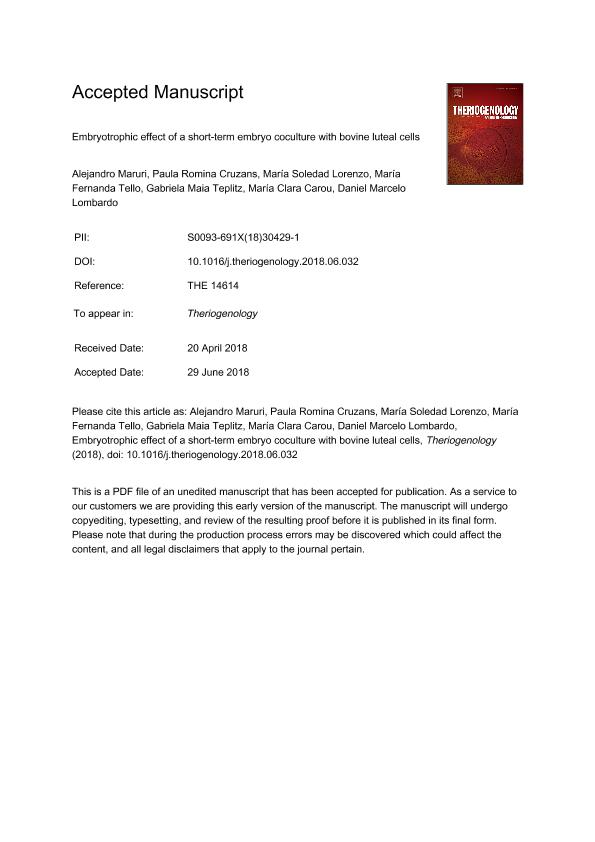Mostrar el registro sencillo del ítem
dc.contributor.author
Maruri, Alejandro

dc.contributor.author
Cruzans, Paula Romina

dc.contributor.author
Lorenzo, María Soledad

dc.contributor.author
Tello, Maria Fernanda

dc.contributor.author
Teplitz, Gabriela Maia

dc.contributor.author
Carou, María Clara

dc.contributor.author
Lombardo, Daniel Marcelo

dc.date.available
2020-01-29T20:40:44Z
dc.date.issued
2018-10
dc.identifier.citation
Maruri, Alejandro; Cruzans, Paula Romina; Lorenzo, María Soledad; Tello, Maria Fernanda; Teplitz, Gabriela Maia; et al.; Embryotrophic effect of a short-term embryo coculture with bovine luteal cells; Elsevier Science Inc; Theriogenology; 119; 10-2018; 143-149
dc.identifier.issn
0093-691X
dc.identifier.uri
http://hdl.handle.net/11336/96167
dc.description.abstract
The coculture with somatic cells is an alternative to improve suboptimal in vitro culture (IVC) conditions and promote embryo development. Several cell types have been used for this purpose, but there is no information about using luteal cells in short-term coculture with embryos. Consequently, this study aimed to assess the effect of a short-term coculture of early bovine embryos-luteal cells on the in vitro development and embryo quality. Presumptive embryos were cultured from day 0 to day 2 in medium alone (control) or cocultured with bovine luteal cells (BLC-1). Then, embryos from both groups were cultured in medium alone from day 2 to day 8. The development rates on day 8 were compared between groups. The level of reactive oxygen species (ROS) and proliferation rates were evaluated in day 2 embryos and late apoptosis and proliferation rates were determined in day 7 blastocysts. Our results showed that the coculture with bovine luteal cells increased the blastocyst rate compared to the control (50.4% vs. 29.8%; P < 0.01), but there were no differences in the cleavage rates on day 2. The rate of stage 6 blastocysts was higher in the coculture (37.3% vs. 23.8% control; P < 0.01), without differences in the expansion and hatching rates compared to the control. The ROS level in day 2 embryos was higher in the coculture than the control (82 vs. 57.1; P < 0.05), and the cell proliferation rate was higher in the coculture (48% vs. 13% control; P < 0.01), without differences in the mean number of cells between groups. In day 7 blastocysts, the apoptosis rate decreased in the coculture with bovine luteal cells from day 0 to day 2 (4.1% vs. 10.9% control; P < 0.01), whereas the cell proliferation rate and the mean number of cells did not differ between groups. This is the first report of a short-term coculture of in vitro produced embryos and bovine luteal cells. Our model could be an alternative to increase the efficiency of the in vitro production of embryos in cattle.
dc.format
application/pdf
dc.language.iso
eng
dc.publisher
Elsevier Science Inc

dc.rights
info:eu-repo/semantics/openAccess
dc.rights.uri
https://creativecommons.org/licenses/by-nc-nd/2.5/ar/
dc.subject
BOVINE EMBRYO QUALITY
dc.subject
BOVINE LUTEAL CELLS
dc.subject
COCULTURE
dc.subject
EMBRYOTROPHIC EFFECT
dc.subject.classification
Tecnologías que involucran la manipulación de células, tejidos, órganos o todo el organismo

dc.subject.classification
Biotecnología de la Salud

dc.subject.classification
CIENCIAS MÉDICAS Y DE LA SALUD

dc.title
Embryotrophic effect of a short-term embryo coculture with bovine luteal cells
dc.type
info:eu-repo/semantics/article
dc.type
info:ar-repo/semantics/artículo
dc.type
info:eu-repo/semantics/publishedVersion
dc.date.updated
2020-01-29T19:11:08Z
dc.journal.volume
119
dc.journal.pagination
143-149
dc.journal.pais
Estados Unidos

dc.description.fil
Fil: Maruri, Alejandro. Universidad de Buenos Aires. Facultad de Ciencias Veterinarias. Instituto de Investigacion y Tecnología en Reproducción Animal; Argentina. Consejo Nacional de Investigaciones Científicas y Técnicas; Argentina
dc.description.fil
Fil: Cruzans, Paula Romina. Universidad de Buenos Aires. Facultad de Ciencias Veterinarias. Instituto de Investigacion y Tecnología en Reproducción Animal; Argentina. Consejo Nacional de Investigaciones Científicas y Técnicas; Argentina
dc.description.fil
Fil: Lorenzo, María Soledad. Universidad de Buenos Aires. Facultad de Ciencias Veterinarias. Instituto de Investigacion y Tecnología en Reproducción Animal; Argentina. Consejo Nacional de Investigaciones Científicas y Técnicas; Argentina
dc.description.fil
Fil: Tello, Maria Fernanda. Universidad de Buenos Aires. Facultad de Ciencias Veterinarias. Instituto de Investigacion y Tecnología en Reproducción Animal; Argentina. Consejo Nacional de Investigaciones Científicas y Técnicas; Argentina
dc.description.fil
Fil: Teplitz, Gabriela Maia. Universidad de Buenos Aires. Facultad de Ciencias Veterinarias. Instituto de Investigacion y Tecnología en Reproducción Animal; Argentina. Consejo Nacional de Investigaciones Científicas y Técnicas; Argentina
dc.description.fil
Fil: Carou, María Clara. Universidad de Buenos Aires. Facultad de Ciencias Veterinarias. Instituto de Investigacion y Tecnología en Reproducción Animal; Argentina
dc.description.fil
Fil: Lombardo, Daniel Marcelo. Universidad de Buenos Aires. Facultad de Ciencias Veterinarias. Instituto de Investigacion y Tecnología en Reproducción Animal; Argentina
dc.journal.title
Theriogenology

dc.relation.alternativeid
info:eu-repo/semantics/altIdentifier/doi/http://dx.doi.org/10.1016/j.theriogenology.2018.06.032
dc.relation.alternativeid
info:eu-repo/semantics/altIdentifier/url/https://www.sciencedirect.com/science/article/pii/S0093691X18304291
Archivos asociados
